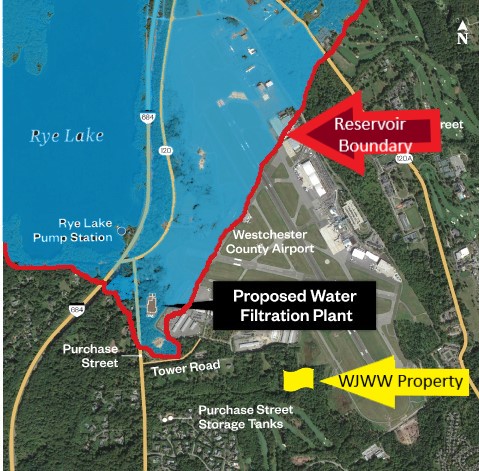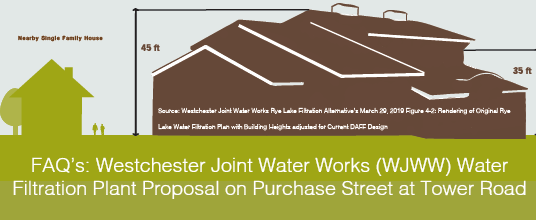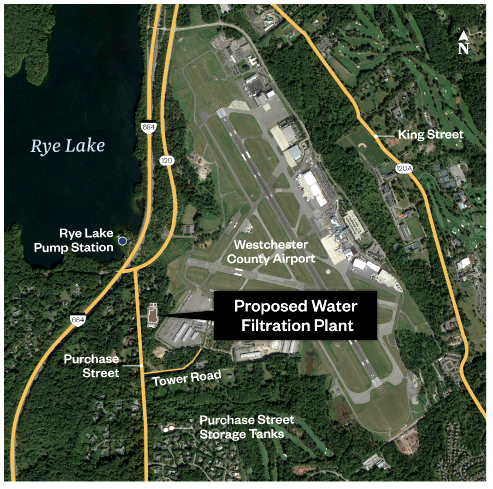
Watershed
Why is WJWW Proposing to Construct a Massive $138 MM Plant in a Protected Watershed When They Own an Alternative Location Outside the Watershed That Can Support the Plant?
PEPA would like WJWW to answer this question. WJWW proposes to build the filtration plant with its “substantial portion…underground” within the sensitive Kensico Reservoir Boundary. However, they own a nearby parcel at 12 Stone Ridge that is outside of the Watershed. It is counterintuitive for WJWW to build the filtration plant in the protected Watershed when they own an alternative location outside the Watershed that can support the filtration plant.
Where is the Plant Proposed to Be Located?
Westchester Joint Water Works' ("WJWW") Rye Lake Water Filtration Plant is proposed to be located within the Kensico Watershed Boundary, on Purchase Street and in a residential neighborhood, adjacent to the Purchase Quaker’s Meeting House and historic burial grounds.
Is there still time to stop this project?
Yes! Although the WJWW Board adopted the FEIS on 9/28/22 the plant can not be built without a land sale by the County. This land sale is subject to a vote by the County Board of Legislators. The date of the BOL vote has not been set. We monitor this daily and will communicate when we know more. There is still time to stop this ill-conceived project!
Has PEPA ever objected to the project previously?
No! PEPA has never objected to the construction of the WJWW plant. Over the course of WJWW's decades-long attempts to construct a filtration plant, PEPA only observed. PEPA did not oppose the project or take action since we are aware this is a court mandated project necessary to comply with surface water treatment rules
However, in 2020 when PEPA learned the WJWW had relocated the project from the site they already own (12 Stoneridge Road) to the Purchase Street site that is located within the Kensico Watershed Boundary we asked WJWW to reconsider and build the plant at its original location.
What Will the Plant Look Like?

Source: Westchester Joint Water Works Website. WJWW Filtration Microsite. Retrieved September 9, 2021, from https://wjwwfiltration.org/. Note the SIngle Family Residence (3) shown is misplaced and not shown to scale.
The nearby "Single-Family Residence" labeled as (3) is not to scale or shown in actual proximity. In reality, the filtration plant will tower above the nearby single-family residences. Furthermore, according to the WJWW website “a substantial portion of the plant will be underground…. adjacent to an active area at Westchester County Airport, which comprises commercial, business and private aviation services.” Construction of substantial, intricate underground plumbing within the watershed seems especially risky.
Using information from a WJWW report (March 2019) PEPA has created an approximation to compare the size of proposed filtration plant to the actual private residence closest to it:
Why Does WJWW Want to Build in the Watershed When They Own an Alternative Location Outside the Watershed That Can Support the Plant?
WJWW proposes to build the filtration plant with a “substantial portion…underground” sited within the sensitive Kensico Watershed. However, they own a nearby parcel at 12 Stone Ridge that is outside of the Watershed. It is risky and counterintuitive for WJWW to build the filtration plant in the protected Watershed when they own an alternative location outside the Watershed that can support the filtration plant.
Source: WJWW website
The yellow highlighted area on the map below shows land WJWW owns. Extensive engineering studies conducted by the water company have already concluded that this parcel can support the proposed plant.
Source: Town Harrison website
Based upon the above images PEPA has created an approximation to show relative location:

Has the NYCDEP Commented On or Raised Concerns About the Location of the Filtration Plant?
Yes! Comments submitted by the NYC Department Environmental Protection during the State Environmental Quality Review Process emphasized the importance of studying alternatives with a focus on “the original 2002 site” for the filtration plant that is located outside of the Kensico Watershed Boundary.
In its comment letter regarding the Draft Scope for DEIS for Westchester Joint Water Works Filtration Plant, Harrison, NY, dated April 16, 2021, the NYCDEP stated:

Click here to read the full comment letter by NYC Department Environmental Protection.
Why is the plant needed? Why is it being constructed?
“Westchester Joint Water Works has been required to construct the filtration plant due to its failure to meet the standards needed for filtration avoidance for a public water supply. A Consent Order was issued by the Westchester County State Supreme Court in 2001 in response to a lawsuit brought by the New York State Department of Health requiring WJWW to proceed with the construction of the plant. More recently, in March 28, 2019, WJWW received a U.S. Environmental Protection Agency (“EPA”) Administrative Order to submit a Corrective Action Plan outlining provisions to be taken to achieve compliance with the disinfection byproduct maximum contaminant levels (“MCLs”), including haloacetic acids and total trihalomethanes. On November 26, 2019, EPA issued a superseding Administrative Order which included an obligation to commence design of the proposed filtration plant. This Administrative Order requires the plant to be in operation by October 15, 2024. PEPA does not disagree that a filtration plant needs to be constructed. However, PEPA does object to the current location selected for the proposed filtration plant, especially when there is an alternative location close by that will have many fewer negative impacts on the community and the environ.”
Does Nature filter water naturally; are those 6 acres of trees on the airport site important?
Yes! Nature works to reduce the amount of artificial treatment needed to filter water for free. Allowing the area within the Watershed to remain in its natural wooded state to function as a green filter would also prevent other harmful pollutants that would be introduced by the filtration plant including construction debris, stormwater runoff, and pollution from daily operations.Trees, wetlands, and other plant materials are great at filtering water. They are the first natural filtration process our source water encounters. Trees in a watershed absorb rainfall and snowmelt, slow storm runoff, recharge aquifers, and filter pollutants from the air and runoff. In fact, when you turn on the faucet to fill your glass, you are drinking water that was filtered largely by trees.

https://www.accotink.org/Stormwater.htm
Why is WJWW Under a Court Mandate to Filter Water While NYC is Allowed to Have Unfiltered Water?
New York City is world-renowned for its clean and delicious drinking water. The NYC Watershed delivers roughly 1.2 billion gallons of water each day to 9 million homes - 90% of New York City and 85% of Westchester. The Watershed’s forests, swamps, and soils act as natural filters, removing pollutants, and making NYC’s drinking water supply the largest unfiltered system in the U.S. (Columbia Climate School)
In order for drinking water to remain unfiltered, all public water companies, including WJWW, are required to obtain a Filtration Avoidance Determination (FAD), Unfortunately, WJWW is one of only three surface water suppliers in New York State that failed to obtain a filtration avoidance determination (FAD) under the Federal Surface Water Treatment Rule enacted in 1991. Because the WJWW was unable to timely obtain a FAD, the New York State Department of Health (DOH) initiated a legal proceeding to require the WJWW to construct a water filtration plant. As a result of this proceeding, the Courts issued an order to construct a water filtration plant. NYC, on the other hand, has obtained a filtration avoidance determination and is able to supply water without filtration.
Why is WJWW Moving Forward and Spending Significant Amounts of Money Developing the Site Without Approvals and Before They Have Considered the Alternative Site or Alternative Proposals?
SEQRA requires “a description and evaluation of the range of reasonable alternatives to the action that are feasible, considering the objectives and capabilities of the project sponsor” (6 N.Y.C.R.R.§617.9(b)). While an applicant is not required to consider sites it does not own or have the option to purchase, an applicant must include the consideration of other properties owned/controlled by WJWW and determine if any of these properties could be used to meet the applicant’s objectives for the project. If viable alternative sites are available, they should be advanced for full evaluation in the DEIS. As discussed above, there is at least one alternative site that is owned by WJWW that was previously considered as a viable location for a water filtration plant in or around 2007-2008 that must be evaluated before WJWW begins to develop the proposed site for the filtration plant. WJWW, however, is continuing to invest significant funds in designing the filtration plant in a location that will have significant negative aesthetic and environmental impacts.
Once Operational, Will the Plant Have Impacts on the Community in Its Current Location?
Yes. According to the WJWW microsite “sound-dampening features will be included in the design.” This location, however, is already surrounded by residential neighbors who are already adversely impacted by noise pollution caused by the airport. This plant’s construction will amplify the noise significantly. Other substantial negative impacts would include construction truck traffic and traffic from deliveries of chemicals and other potentially hazardous materials once the filtration plant is operational.
Of greater concern are the negative aesthetic impacts that will result from the construction of the filtration plant. The proposed filtration plant will be significantly larger than a residential facility and will be much closer to Purchase Street than any of the existing airport structures. It will also be much more visible to the public from Purchase Street. Further, trees act as a sound barrier and to build the filtration plant in the proprosed location requires the removal of over 10 acres of trees that are currently acting as a buffer to airport noise.
Does the Town’s Master Plan Discuss the Importance of Longterm Protection of the Kenisco Watershed?
Yes, it does, in many places, including Chapter 2 and Chapter 6.
Chapter 2: Townwide Analyses declares the important role Kensico plays in providing clean water for nine million people. “As Harrison obtains its water from this water supply system, the protection of the quality of Kensico is vital for both New York City and Harrison. Kensico Reservoir the Kensico Reservoir is the final stop for 90% of New York City’s drinking water supply before it enters the water tunnels that carry it to consumers’ taps. Normally, all of the water from the City’s Catskill and Delaware watersheds – located in parts of Ulster, Delaware, Greene, Schoharie and Sullivan Counties west of the Hudson River – flows into the Kensico Reservoir.” (page 74)
This chapter also points out the importance of regulating “stormwater management in the northern portion of Harrison, within the city’s watershed boundary, due to the critical role of Kensico Reservoir in New York City’s water supply. NYCDEP has set down regulations for development in the form of the Rules and Regulations for the Protection from Contamination, Degradation, and Pollution of the New York City Water Supply and its Sources (Watershed Regulations) 1997.” (Page 71)
Chapter 6 Plan Concepts and Future Use Plans states that “the Kensico Reservoir requires protection. There are a number of natural resources requiring protection: steep slopes, wetlands, watercourses, ponds, and Kenisco Reservoir. Harrison already controls development that might harm any of these resources, as does the New York City Department of Environmental Protection through its Watershed Regulations. This plan recommends revising regulations to more clearly create permanently preserved open space. Such open space may be habitat or environmentally sensitive land. This change would lead to greater protection of environmental resources in future large-scale development.” (Page 138)
Final thoughts: Given the importance of the Kensico Watershed, it makes no sense to construct a large industrial filtration plant in the area selected by WJWW. This is especially true when WJWW owns an alternative location that has already been studied and exists outside of the protected Watershed.
How Can You Help?
- Click here to Sign the Online Petition to Just Say “No” the WJWW Land Swap
- Write a letter to the Westchester County legislators or your local newspaper
- Attend the WJWW Board monthly meetings with virtual access. Check their website at https://www.wjww.com/ for dates and zoom links.




.png)
